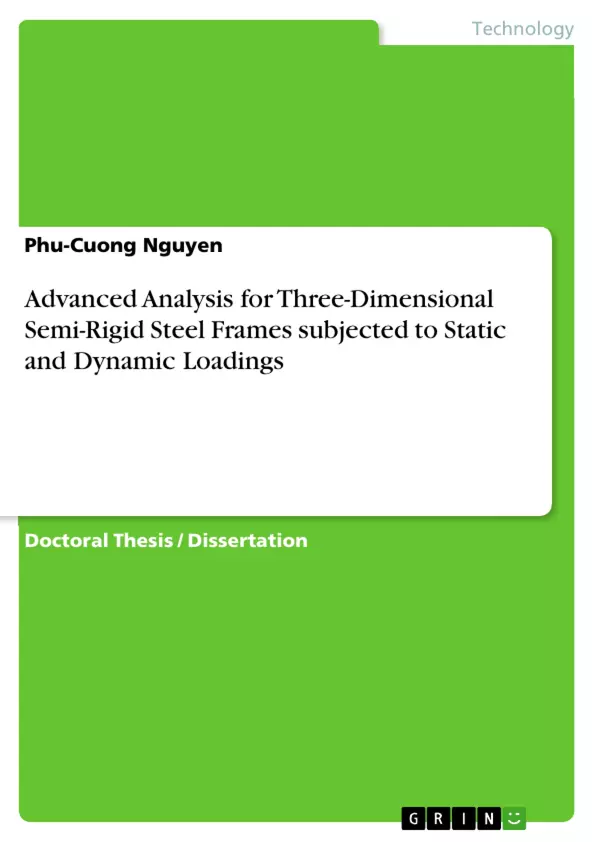This dissertation presents three various advanced analysis approaches which can capture accurately and efficiently the ultimate strength and behavior of steel framed structures with nonlinear beam-to-column connections subjected to static and dynamic loadings. Three major sources of nonlinearity are considered in the analyses as follows: (1) material nonlinearity; (2) geometric nonlinearity; and (3) connection nonlinearity. Three types of nonlinear beam-column element formulation considering both geometric and material nonlinearities are coded into two nonlinear structural analysis programs: (1) Nonlinear Structural Analysis Program (NSAP) – 2-D plastic-zone finite element; (2) Practical Advanced Analysis Program (PAAP) – 3-D refined plastic-hinge element and 3-D plastic-fiber element. Three types of steel frames analyzed by the proposed program are: (1) rigid frames – beam-to-column connections are fully rigid; (2) linear semi-rigid frames – beam-to-column connections have constant stiffness; and (3) nonlinear semi-rigid frames – beam-to-column connections have continuously variable stiffness. Three types of analysis can be performed are: (1) nonlinear inelastic static analysis; (2) nonlinear elastic and inelastic time-history analysis; and (3) free vibration analysis. Three main resources of damping are taken into account in the proposed programs are: (1) hysteretic damping due to inelastic material; (2) structural viscous damping employing Rayleigh damping; (3) hysteretic damping due to nonlinear beam-to-column connections.
Two computer programs are developed: (1) Nonlinear Structural Analysis Program (NSAP) – written in the C++ programming language; (2) Practical Advanced Analysis Program (PAAP) – written in the FORTRAN 77 programming language. They are verified for accuracy and computational efficiency by comparing predicted results with those generated by the commercial finite element analysis packages of ABAQUS and SAP2000, and other results available in the literature. Through several numerical examples, the proposed program (PAAP) proves to be a reliable and efficient tool for daily practice design in lieu of using costly and time-consuming commercial software.
Inhaltsverzeichnis (Table of Contents)
- Abstract
- Introduction
- Literature Review
- Theoretical Background
- Numerical Analysis
- Validation and Case Studies
- Conclusions and Future Research
- References
Zielsetzung und Themenschwerpunkte (Objectives and Key Themes)
The main objective of this dissertation is to investigate the behavior of three-dimensional semi-rigid steel frames subjected to static and dynamic loadings. The research focuses on developing advanced analytical models and numerical methods to accurately predict the structural response of these frames, considering the effects of semi-rigid connections and different loading conditions. This study also aims to validate the proposed models against experimental and numerical results obtained from existing studies.
- Semi-rigid connection behavior in steel frames
- Advanced analytical models for three-dimensional steel frames
- Numerical methods for static and dynamic analysis
- Validation of proposed models against experimental and numerical results
- Applications of the developed models to practical engineering problems
Zusammenfassung der Kapitel (Chapter Summaries)
- Abstract: This chapter provides a concise overview of the dissertation's objectives, methodology, and key findings.
- Introduction: This chapter introduces the research background, the significance of semi-rigid steel frames, and the motivation for this study. It also outlines the research objectives and the scope of the investigation.
- Literature Review: This chapter presents a comprehensive review of existing literature on the behavior of semi-rigid steel frames, focusing on relevant analytical models, numerical methods, and experimental investigations. It identifies research gaps and highlights the need for further investigation.
- Theoretical Background: This chapter presents the theoretical foundation for the analysis of semi-rigid steel frames. It includes the formulation of constitutive relationships for semi-rigid connections, the derivation of governing equations for frame analysis, and a discussion of the relevant theoretical concepts.
- Numerical Analysis: This chapter focuses on the development of numerical methods for the analysis of semi-rigid steel frames. It discusses the implementation of advanced finite element techniques and the use of commercially available software for solving the governing equations.
- Validation and Case Studies: This chapter presents the validation of the proposed models and numerical methods through comparisons with experimental data and numerical results from other studies. It also includes case studies to demonstrate the applicability of the developed models to practical engineering problems.
Schlüsselwörter (Keywords)
This research focuses on the analysis of three-dimensional semi-rigid steel frames subjected to static and dynamic loads. Key concepts and themes include semi-rigid connections, advanced analytical models, numerical methods, finite element analysis, validation studies, case studies, and practical engineering applications. The dissertation aims to contribute to the advancement of knowledge in structural engineering by providing insights into the behavior of semi-rigid steel frames and developing tools for their efficient and accurate design.
- Quote paper
- Dr. Phu-Cuong Nguyen (Author), 2014, Advanced Analysis for Three-Dimensional Semi-Rigid Steel Frames subjected to Static and Dynamic Loadings, Munich, GRIN Verlag, https://www.grin.com/document/1358749



